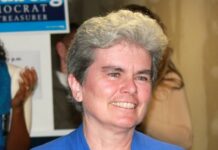BOSTON, Feb. 28 —
Ann Hartstein, Secretary of the Executive Office of Elder Affairs (EOEA), testified before the Joint Committee on Ways and Means about the FY 14 budget which is now being developed on Beacon Hill.
“I want to start with demographics, ”Hartstein told lawmakers. “Baby boomers who are now turning 65, are doing so at the rate of approximately 10,000 individuals per day across the country. Life expectancy in the Commonwealth is 80.2 years, which is two years older than the national average. In the next decade, the number of people age 60 or older in Massachusetts will increase by more than a quarter of a million, to nearly 1.6 million people. Currently 1 in 5 Massachusetts residents are over the age of 60. That will increase to 1 in 4 by 2030. Of these, statistically speaking, two-thirds will need some assistance in meeting their long term care support needs at some point in their lives. People over age 85 are the fastest growing segment of our population, and it is this group of individuals whom are more likely to need assistance to sustain an independent and quality life.”
Secretary Hartstein noted that as part of a legislative reorganization a decade ago, the EOEA was granted expanded management control over long term support services. “With the administrative reorganization in 2003, the MassHealth Office of Long Term Care was integrated with the Executive Office of Elder Affairs,” Hartstein testified, “ thus streamlining and maximizing the programmatic, fiscal, advocacy and policy components of support services for elders and people of all ages with disabilities and thereby eliminating fragmentation and duplication.
This change integrated the management of Medicaid funding, which pays for a range of home and community based long term care, medical services and services provided in nursing facilities for people of all ages. Elder Affairs and MassHealth’s Office of Long Term Care, now called the Office of Long Term Services and Supports (OLTSS), is responsible for managing the MassHealth funding for care management and medical support services for elders and persons with disabilities. This integration also supports the administration’s commitment to Community First allowing individuals of all ages in need of services to remain in their homes or in the least restrictive settings of their choice.”
But critics of the administration, including Mass Home Care, argue that Gov. Patrick never implemented the 2003 reorganization, and in fact made the EOEA report to the Executive Office of Health and Human Services (EOHHS). The governor actually prepared a plan to move MassHealth control back to EOHHS, but when elder advocates objected, the governor withdrew his formal reorganization plan. But he accomplished the same agenda by giving EOHHS operational control over EOEA.
One recent example is the development of a large, mandatory managed care program for 110,000 people on MassHealth and Medicare from age 21 to 64. EOHHS has expanded that program to allow people 65 and over to remain in the managed care plan, effectively usurping powers granted to EOEA under Chapter 19A, 4B. The new plan duplicates in many ways an existing managed care plan for elders known as the Senior Care Organizations.
Regarding the Governor’s FY 14 budget, the secretary said she was “very pleased to report that the governor’s budget recommendations for Elder Affairs offer responsible, balanced and innovative solutions to address the ongoing fiscal challenges facing the Commonwealth. Furthermore, it reflects a strong, ongoing commitment to the elders of the Commonwealth, to the Community First Agenda, and to the maintenance of the home- and community-based system of care we need for people of all ages.”
But advocates charge that the governor’s budget provides no additional funding for key elderly programs like home care, and the enhanced home care program (ECOP). Secretary Hartstein acknowledged in her testimony that the governor’s budget “keep(s) most programs fully intact at FY13 funding levels, ensuring sustainable progress towards our strategic goals and initiatives.” But the home care purchased services account has fallen from $106.7 million in 2009, to $97.7 million in 2013. The funding that pays for care managers and operations at the Aging Services Access Points is now lower than it was in 2006 — more than seven years ago.
Under questioning from lawmakers, EOEA was asked how much money would be required to end the waiting lists in home care, which have dogged the system for the past 12 months. Secretary Hartstein told Ways & Means that it would cost $3.4 million to eliminate the home care wait list and $4.5 million to end the wait list for enhanced home care. She also said if the legislature funded both programs together, the total cost would be $6.5 million — because moving Enhanced Community Option Program (ECOP) clients off the wait list opens up home care slots. Upon further questioning, Hartstein said the home care wait list as of mid February was around 800, and the wait list for ECOP stood at 400.
Re-printed from the Mass Home Care bulletin with permission.












